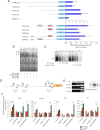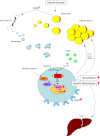Loss of Pdk1-Foxo1 signaling in myeloid cells predisposes to adipose tissue inflammation and insulin resistance
- PMID: 22586579
- PMCID: PMC3402298
- DOI: 10.2337/db11-0770
Loss of Pdk1-Foxo1 signaling in myeloid cells predisposes to adipose tissue inflammation and insulin resistance
Abstract
Chronic inflammation in adipose tissue contributes to obesity-related insulin resistance. The 3-phosphoinositide-dependent protein kinase 1 (Pdk1)/forkhead transcription factor (Foxo1) pathway is important in regulating glucose and energy homeostasis, but little is known about this pathway in adipose tissue macrophages (ATMs). To investigate this, we generated transgenic mice that carried macrophage/granulocyte-specific mutations, including a Pdk1 knockout (LysMPdk1(-/-)), a Pdk1 knockout with transactivation-defective Foxo1 (Δ256LysMPdk1(-/-)), a constitutively active nuclear (CN) Foxo1 (CNFoxo1(LysM)), or a transactivation-defective Foxo1 (Δ256Foxo1(LysM)). We analyzed glucose metabolism and gene expression in ATM populations isolated with fluorescence-activated cell sorting. The LysMPdk1(-/-) mice exhibited elevated M1 macrophages in adipose tissue and insulin resistance. Overexpression of transactivation-defective Foxo1 rescued these phenotypes. CNFoxo1(LysM) promoted transcription of the C-C motif chemokine receptor 2 (Ccr2) in ATMs and increased M1 macrophages in adipose tissue. On a high-fat diet, CNFoxo1(LysM) mice exhibited insulin resistance. Pdk1 deletion or Foxo1 activation in bone marrow-derived macrophages abolished insulin and interleukin-4 induction of genes involved in alternative macrophage activation. Thus, Pdk1 regulated macrophage infiltration by inhibiting Foxo1-induced Ccr2 expression. This shows that the macrophage Pdk1/Foxo1 pathway is important in regulating insulin sensitivity in vivo.
Figures








Similar articles
-
PDK-1/FoxO1 pathway in POMC neurons regulates Pomc expression and food intake.Am J Physiol Endocrinol Metab. 2010 Apr;298(4):E787-98. doi: 10.1152/ajpendo.00512.2009. Epub 2010 Jan 26. Am J Physiol Endocrinol Metab. 2010. PMID: 20103739
-
PDK1-Foxo1 in agouti-related peptide neurons regulates energy homeostasis by modulating food intake and energy expenditure.PLoS One. 2011;6(4):e18324. doi: 10.1371/journal.pone.0018324. Epub 2011 Apr 7. PLoS One. 2011. PMID: 21694754 Free PMC article.
-
The PDK1-FoxO1 signaling in adipocytes controls systemic insulin sensitivity through the 5-lipoxygenase-leukotriene B4 axis.Proc Natl Acad Sci U S A. 2020 May 26;117(21):11674-11684. doi: 10.1073/pnas.1921015117. Epub 2020 May 11. Proc Natl Acad Sci U S A. 2020. PMID: 32393635 Free PMC article.
-
Forkhead Box O1 Regulates Macrophage Polarization Following Staphylococcus aureus Infection: Experimental Murine Data and Review of the Literature.Clin Rev Allergy Immunol. 2016 Dec;51(3):353-369. doi: 10.1007/s12016-016-8531-1. Clin Rev Allergy Immunol. 2016. PMID: 26924010 Review.
-
Insulin resistance in adipose tissue and metabolic diseases.Diabetol Int. 2022 Dec 22;14(2):119-124. doi: 10.1007/s13340-022-00616-8. eCollection 2023 Apr. Diabetol Int. 2022. PMID: 37090134 Free PMC article. Review.
Cited by
-
αMSH inhibits adipose inflammation via reducing FoxOs transcription and blocking Akt/JNK pathway in mice.Oncotarget. 2017 Jul 18;8(29):47642-47654. doi: 10.18632/oncotarget.17465. Oncotarget. 2017. PMID: 28514752 Free PMC article.
-
MST1 is a key regulator of beta cell apoptosis and dysfunction in diabetes.Nat Med. 2014 Apr;20(4):385-397. doi: 10.1038/nm.3482. Epub 2014 Mar 16. Nat Med. 2014. PMID: 24633305 Free PMC article.
-
3-Phosphoinositide-Dependent Kinase 1 as a Therapeutic Target for Treating Diabetes.Curr Diabetes Rev. 2025;21(4):47-56. doi: 10.2174/0115733998278669240226061329. Curr Diabetes Rev. 2025. PMID: 38468518 Review.
-
Downregulation of macrophage Irs2 by hyperinsulinemia impairs IL-4-indeuced M2a-subtype macrophage activation in obesity.Nat Commun. 2018 Nov 19;9(1):4863. doi: 10.1038/s41467-018-07358-9. Nat Commun. 2018. PMID: 30451856 Free PMC article.
-
Ablation of macrophage transcriptional factor FoxO1 protects against ischemia-reperfusion injury-induced acute kidney injury.Acta Pharm Sin B. 2025 Jun;15(6):3107-3124. doi: 10.1016/j.apsb.2025.04.009. Epub 2025 Apr 10. Acta Pharm Sin B. 2025. PMID: 40654361 Free PMC article.
References
-
- Qatanani M, Lazar MA. Mechanisms of obesity-associated insulin resistance: many choices on the menu. Genes Dev 2007;21:1443–1455 - PubMed
-
- Olefsky JM, Glass CK. Macrophages, inflammation, and insulin resistance. Annu Rev Physiol 2010;72:219–246 - PubMed
-
- Saltiel AR, Kahn CR. Insulin signalling and the regulation of glucose and lipid metabolism. Nature 2001;414:799–806 - PubMed
-
- Welham MJ, Bone H, Levings M, et al. . Insulin receptor substrate-2 is the major 170-kDa protein phosphorylated on tyrosine in response to cytokines in murine lymphohemopoietic cells. J Biol Chem 1997;272:1377–1381 - PubMed
-
- Frittitta L, Grasso G, Munguira ME, Vigneri R, Trischitta V. Insulin receptor tyrosine kinase activity is reduced in monocytes from non-obese normoglycaemic insulin-resistant subjects. Diabetologia 1993;36:1163–1167 - PubMed
Publication types
MeSH terms
Substances
LinkOut - more resources
Full Text Sources
Molecular Biology Databases
Research Materials
Miscellaneous

